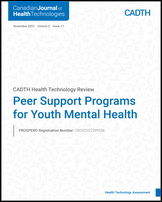|
Self-efficacy Related to Secrecy and Disclosing of mental illness
Post-intervention: 107 (1 RCT
39
)
Post booster: 97 (1 RCT
39
)
Longest follow-up: 55 (1 RCT
40
)
| One RCT39,40 with high risk of bias (unclear direction) reported on participants’ self- efficacy related to secrecy and disclosure of mental illness. The outcome was assessed by 2 questions - “How confident are you in making decisions and handling well all the issues related to disclosing your mental illness?” (p.171)39 and “How confident are you in making decisions and handling well all the issues related to keeping mental illness a secret?” Answers were rated from 1 (not at all) to 7 (very much). Conley et al.,39 compared HOP-C with no peer support among university students with self-identified mental health concerns. The participants (n =117) were mostly female (82.2%), White (68.6%) and heterosexual (66.9%), and reported depressive symptoms (85.5%). The trial39 showed that at post-intervention there may be little to no difference in the effect of peer support in efficacy related to keeping the mental illness a secret or to that related to disclosure of mental illness compared to no peer support.39 At post-booster, the trial showed that HOP may be favoured with respect to self-efficacy about disclosure (p =0.001) but there may be little to no difference in self-efficacy related to keeping mental illness a secret.39 At the 2 month follow-up assessment, the results suggested that there may be little to no difference in the effect of peer support vs. no peer support (waitlist) in self-efficacy related to secrecy or to disclosing mental illness.40 |
Very low
due to serious concerns for risk of bias, inconsistency, indirectness, and imprecision.a
| There may be little to no difference in the effect of HOP vs. waitlist control on self-efficacy about secrecy and disclosing mental illness post-intervention, but the evidence is very uncertain. HOP may be favoured vs. waitlist control with respect to self-efficacy about secrecy and disclosing mental illness post-booster, but the evidence is very uncertain. There may be little to no difference in the effect of HOP vs. waitlist control on self-efficacy about secrecy and disclosing mental illness at 2 months follow-up, but the evidence is very uncertain. |
